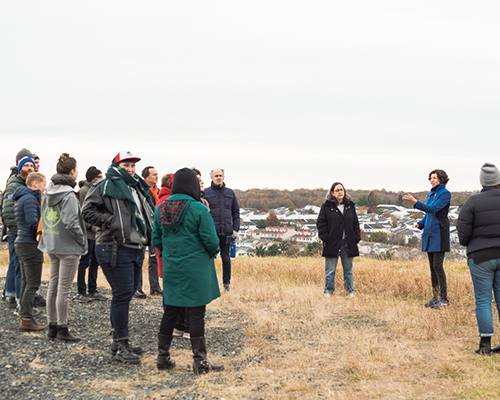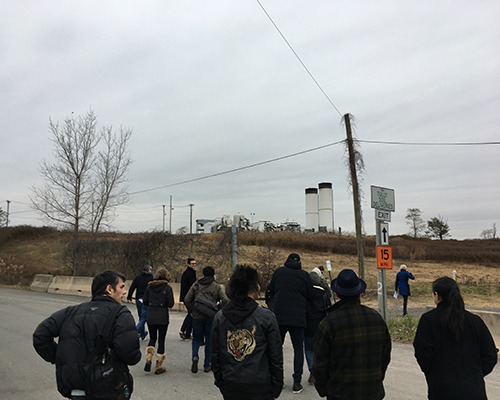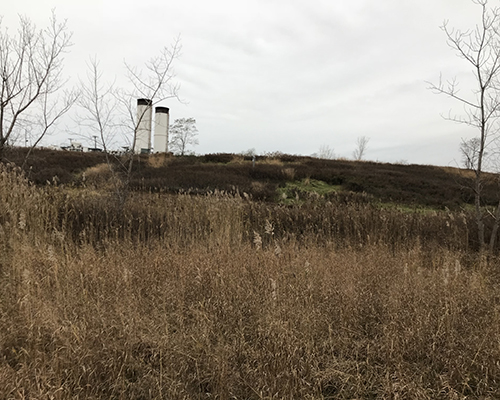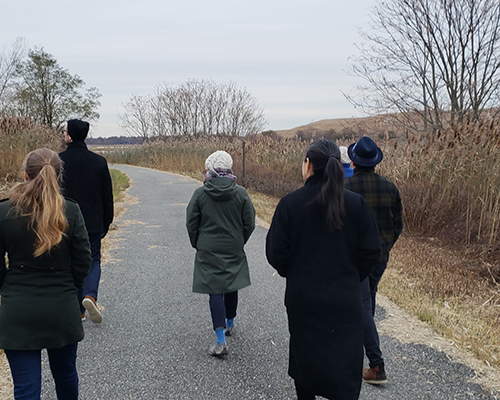



Two tours on a cold day in November 2018 explored Fresh Kills’ landfill-to-park project within the long trajectory of the changing urban environment in Staten Island, and an even longer trajectory of geologic time. Participants experienced the constructed and natural infrastructure that has shifted the Freshkills ecosystem from landscape to wastescape and back to landscape again. They learned how the early stages of this very long-term project have already created productive habitat for non-humans.
I led the tours in collaboration with Mariel Villeré (former Manager for Programs, Arts, and Grants, Freshkills Park) and Cait Field (Manager for Science and Research Development, Freshkills Park).
Itinerary
St George Ferry Terminal, Staten Island
Board the bus.
Clove Road to 278: geologic time
450 million years ago, a subduction zone formed. It was cataclysmic— volcanoes, earthquakes, magma pushed up from under the earth. This created a mass of serpentinite, a greenish rock composed of various minerals. This serpentinite mass runs from Alabama to Newfoundland; the Appalachians; a big chunk of it appears in Staten Island—you can see it on either side of the highway. Locally it was mined for iron ore, in what’s now Todt Hill.
18,000 years ago, glaciers formed in the last ice age started to melt. A giant ice sheet covered the East Coast, the upper US and almost all of Canada. At its edge it deposited a ridge of rocky material, called the terminal moraine. The terminal moraine runs through Staten Island, Brooklyn, and Queens, and is among the highest and rockiest parts of these boroughs. The 278 travels along the terminal moraine.
This tour is framed by timescales. The serpentinite mass and the terminal moraine are visible records of geologic time. The timescale of human existence is comparatively small, but we’ve had a big impact on the environment: the Anthropocene.
Exit to the 440: geology is destiny
The landscape flattens out here-- we’re in marshland. Fresh Kills was built on former marshland. There is clay underneath, the result of glacial deposits. This clay spawned a local brickmaking industry in the 1800s. It also gave Robert Moses, who considered this area a “wasteland,” a good reason for siting a landfill—clay made a natural barrier between the landfill and groundwater. Local conservationists and naturalists resisted Moses’ terminology and opposed the landfill from the beginning.
Enter Freshkills through Department of Sanitation
This is the Department of Sanitation's (DSNY) active site. You’ll see garages for garbage trucks, heavy equipment, etc. Here’s where the tents for 9/11 recovery and areas for equipment staging during Superstorm Sandy recovery were sited. Fresh Kills is also a space resource and utility, uses which are separate from the landfill operations.
Up to South Mound
South Mound was first capped in 1996. It’s more wooded and forested than other mounds. The edges were outside of the original landfill, which is why it’s a more mature forest compared to other parts of the site.
Atop South Mound: the establishing shot
Here you get a sense of the scale of the Fresh Kills landfill project, and also the potential for the scale of the Freshkills Park project. Here you are standing on 150 million tons of trash. If you were living or passing through NYC between 1948-2001 and threw something away, it is most likely landfilled here.
Here you get a view of the Arden Heights neighborhood and Village Greens development, which are very close to the site. Why was housing built so close to a landfill? In the late 1960s there was a call to develop the southwest of Staten Island for planned residential communities that would combat urban sprawl. At that point, the landfill was relatively flat, and possibly hidden to these development sites. Village Greens was built in 1971-- only a year earlier a plan was proposed to build mounds in order to store more trash and at least 10 more years out of the landfill.
After the early 1970s, Fresh Kills began to have more widespread impacts on Staten Islanders as it got bigger and higher. Imagine what it was like to live with an enormous landfill in your backyard. Smells, dust, noise, truck traffic, rats, tens of thousands of gulls... It was a major environmental justice issue.
Down from South Mound: the politics of erasure
Many Staten Islanders want the landfill and the memory of the time when it was active to be erased. This is why park proposals to have, for example, a viewing tunnel down into the landfill were locally unpopular. In many parts of Fresh Kills, it’s easy to forget you’re standing on 53 years worth of garbage. That history is purposefully rendered invisible by a 3 to 12 foot soil layer and a grasslands cover.
What’s also invisible, however, is our waste stream today. Since the landfill was closed, all of our trash goes to other communities in other places, as close as New Jersey (the Covanta Waste-to-Energy plant in Newark) and landfills in upstate NY near the Fingerlakes, and as far away as South Carolina. The waste stream is invisible to almost everyone in NYC except the workers who handle it. Out of sight, out of mind.
What parts of this waste history should we forget, make invisible? Or, what should we remember/keep visible, and how?
Atop East Mound: accidental ecosystems
The mounds are maintained through mowing. East Mound is a more recent cap, so there is different infrastructure and therefore a different environment/ecosystem from other mounds. There is a documented species difference between the mounds—for example, the grasshopper sparrow appears on East Mound and not elsewhere. The Parks Department is doing research on these inhabitants, including through sound recordings. They are adapting the master plan for bird habitat.
Lower North Mound, along Main Creek: from wetlands to forest
The city drowns out a lot of sensory perception. Walk silently on the path along the Creek. Use all of your subtle senses. Listen. Become aware of the ground, air, water. What do you hear/smell/sense/feel?
Here, it’s easy to forget we’re on a former landfill that contains 150 million tons of trash, produces about 3 million cubic feet of landfill gas (methane and carbon dioxide) per day, and that creates and treats 300,000 gallons of leachate in a day.
Up to North Mound: wilderness in the city
Fresh Kills is in a unique moment in time-- the landfill has been closed and capped and planted; but the master plan for the park has not been fully put into place-- it’s happening bit by bit. It’s in this in-between space and time. It’s a space of possibility for wildlife, for scientists, for artists.
For most of the year, much of the site has very little human interaction. Public access is limited to tours and field days, in limited areas. There is some DSNY truck traffic but only on the paved roads. The mounds are only mowed once a year, after fall migration. So Fresh Kills has been able to “develop on its own.” This moment in time is a kind of “wild” state for Fresh Kills, maybe even a wilderness.
There’s a history of wastelands becoming wild places, mostly because they’re off limits for one reason or another and nature takes over. Freshkills, though, isn’t a natural place because of abandonment or enclosure, it’s a deliberate, human-created ecosystem. And it’s a very productive one— at the moment it’s productive for non-humans (plants, birds, animals, mollusks, etc). When it becomes a park, it will be very productive for humans as well. This landscape could be one where humans and non-humans continue to co-produce and change it into the future.
Atop North Mound: overlapping timescales
You can see the serpentinite body from here. It’s a reminder of the simultaneous timescales this land is in. The geologic timescale is represented by serpentinite, a physical reminder of ancient geological forces. The human timescale, in which change happens very rapidly, can also be seen here. The transformation of Freshkills from landfill to park is one example. The changing waterfront and harbor is another—for example enlarged bridges and dredged channels to accommodate super ultra large container ships.
The timeline for the completion of Fresh Kills Park could end up being as lengthy as the tenure of the landfill. It’s a project that will stretch through multiple decades, and through multiple political administrations.
Back to the Ferry via Richmond Terrace: the future is development?
Along Richmond Terrace, you can see some of the more industrial parts of the West Shore. For many years this area was underused and decaying, but now it’s active with maritime industries like tugboat companies. The West Shore is being developed further-- the creation of Fresh Kills Park parallels increased commercial and industrial development. As climate change increases storm surges, Fresh Kills Park will be an important buffer for this side of Staten Island.
Related Links:
>Freshkills Park: Field R/D website
>Art and Ecology, Bomb Magazine, Feb 5 2019